Did you know that on average an email list loses about 22,5% of its subscribers each year?
Even when you’re sending out great emails, people might lose interest over time, delete their user account, or just dealing with too many emails in their inbox. Whatever the reason, it’s frustrating to realize that your email engagement is going down.
Luckily, all is not lost when you notice someone isn’t opening, clicking or taking the actions you’d like. You can still boost your email engagement rate by setting up re-engagement campaigns. These campaigns help you to reduce your list churn rates, boost engagement, and improve your overall deliverability.
Find the reason why someone stops engaging
When it comes to creating effective re-engagement emails, it’s essential to understand your customers. Try to figure out why they’re not engaging anymore. People have various motivations to stop engaging and each reason might ask for a different approach. With this information, you can get personal with them and send a personalized solution or offer.
Someone might stop engaging because they signed up for information and updates. Instead they’ve been receiving promotions and sales pitches non-stop. That’s not what they asked for. Result: they lose interest and start ignoring your emails.
Maybe you notice that your bounce rate is going up? In that case it’s advised to clean your email list and remove the inactive email addresses. You’ll end up with a smaller list but at least you’ll notice a positive impact on your engagement and deliverability.
For list cleaning we advise the useful tool Datavalidation. You upload your entire list and the tool will verify each email address for you. The inactive email addresses are then removed.
You can also dive deeper into specific situations and cross-reference different communication touchpoints. Did they have an issue with a product or a service? Did they contact customer support for help? How did that go?
Uncovering hidden hiccups in your customer experience can help you understand why people stop engaging with your business.
Better segmentation = better engagement
It’s always a good idea to segment your email list. Even when we’re talking about inactive or dormant subscribers. You’re going to need a different approach for people who open your emails but don’t click, and people who don’t even open them. The same goes for short-term and long-term inactivity. There’s a difference between someone who hasn’t used your discount offer after a week and someone who hasn’t opened your emails in months.
Set up segments based on different engagement criteria and tweak your email communication based on their specific situation.
Re-engagement email examples to get you inspired
Duolingo
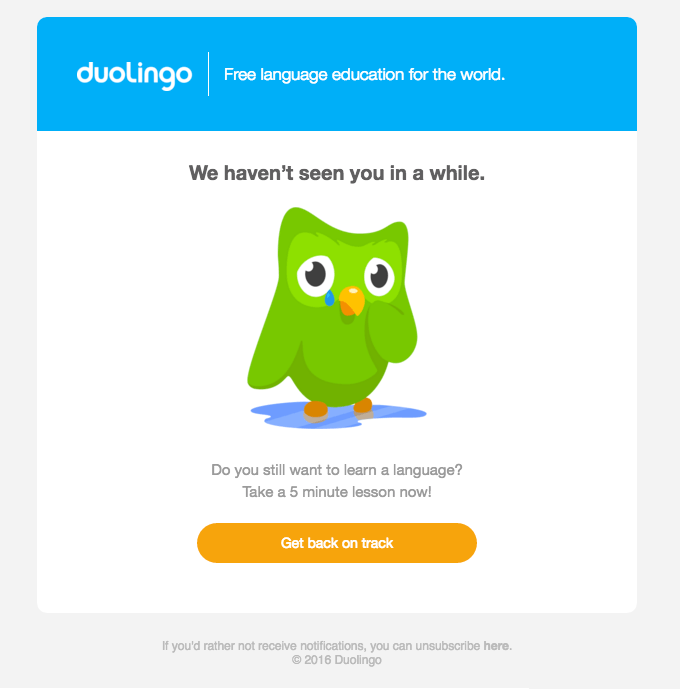
Source: Reallygoodemails.com
Duolingo knows that learning a new language requires consistent practice. Just like a teacher in class, they push you to do your homework and deliver results. That’s why they will send you timely reminders to get back on track as soon as they notice a drop in engagement. These little nudges make sure that their users keep performing and reach their language goals.
Zapier
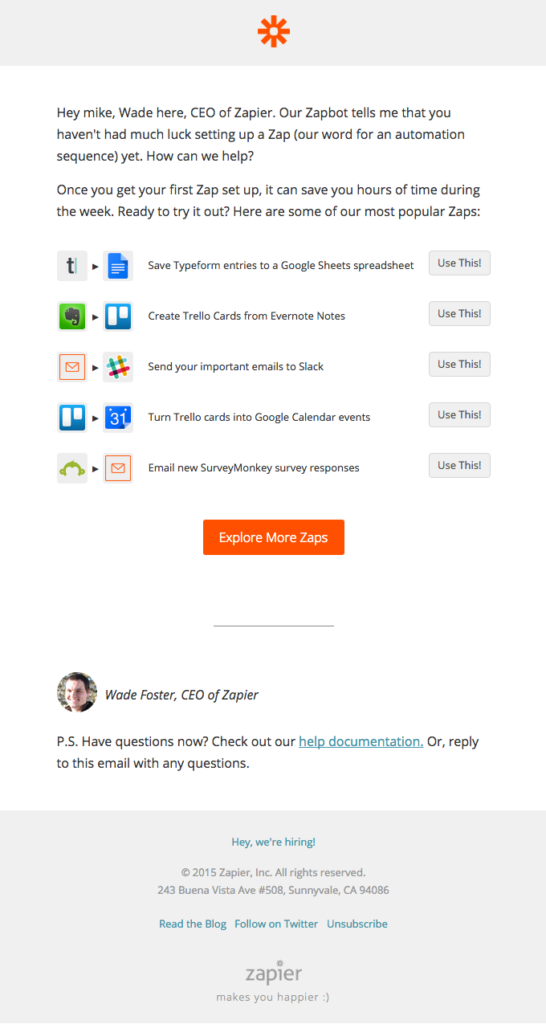
Source: Reallygoodemails.com
This simple and straightforward re-engagement email from Zapier is targeted to those who have signed up for a Zapier account but haven’t created a ‘zap’ yet. If these idle users create their first zap they might see the value of their service, start creating more zaps and eventually… buy their premium plan. But the first step is to get them to try it once. That’s why Zapier inspires them with a selection of the most popular zaps and urges them to explore more options.
Animoto
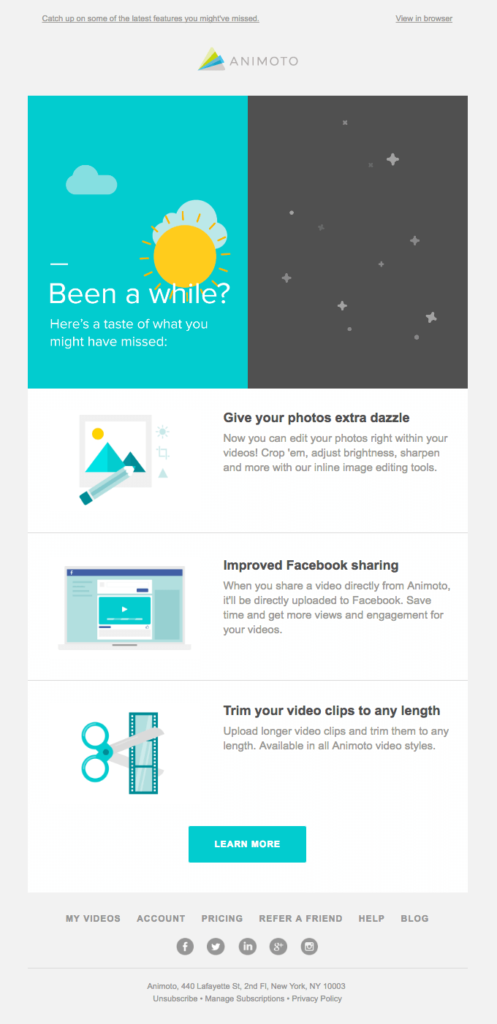
Source: Reallygoodemails.com
This email from Animoto points out that it’s been a while since they’ve seen any engagement from you. And of course, they want to make sure that you keep using their online video editing tool. By showcasing their latest product improvements they might be able to inspire you to start a new video project.
ReturnPath
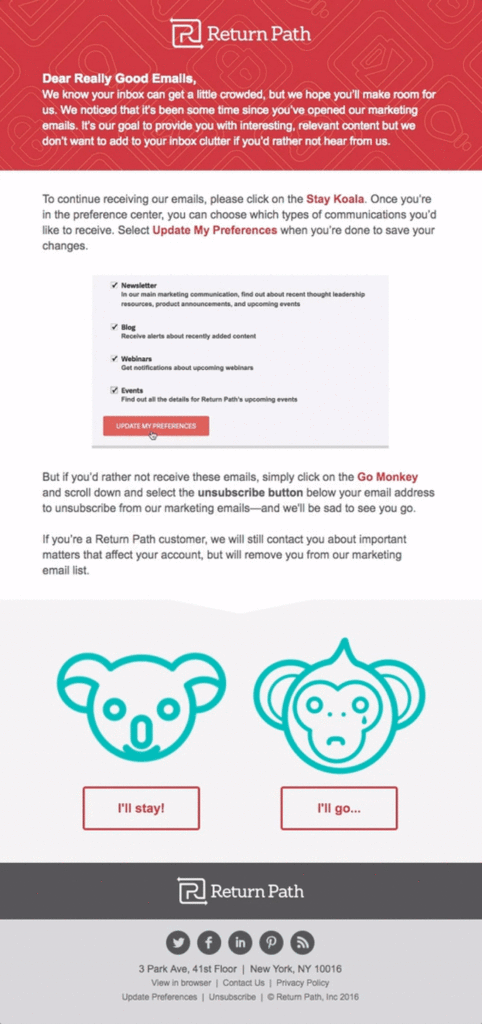
Source: Reallygoodemails.com
As experts in email deliverability, ReturnPath knows the importance of email engagement (and the impact it has on deliverability). That’s why they don’t want to send emails to people who don’t care about them. They identified their readers with the lowest engagement and contacted them.
In this email they sympathize with the reader. They understand that it’s not fun to deal with an overcrowded inbox. ReturnPath respects the changing needs of their readers and offers the choice to adjust their email preferences or opt-out completely. It’s a smart, pro-active re-engagement campaign that ensures high list quality, improves email deliverability and campaign results.
Teespring
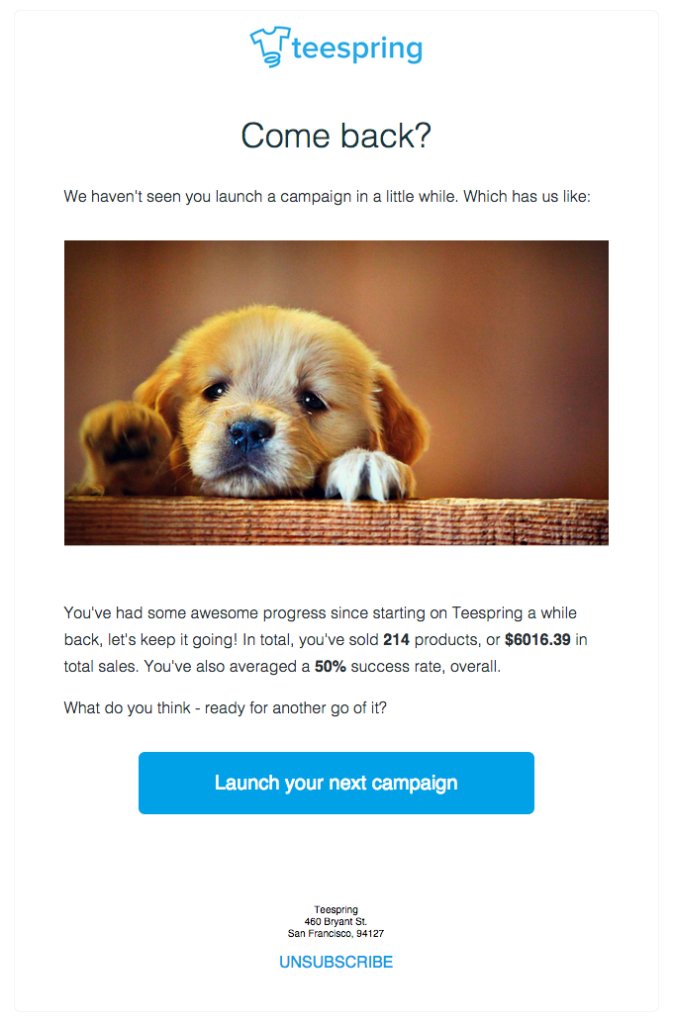
Source: Reallygoodemails.com
When Teespring notices you haven’t been very active on their platform, they send out this re-engagement email to get you back on track. We love how they use data to personalize the message and show you how well you’ve been doing so far. This might be a strong trigger to start a new campaign and start using their platform again.
Jack Wills
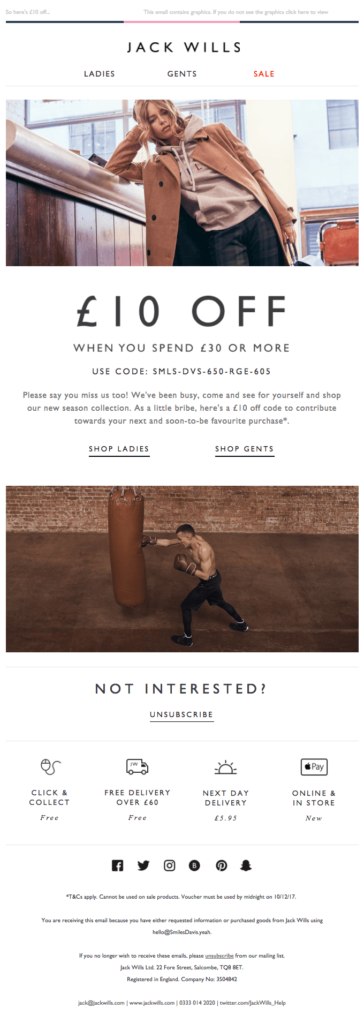
Source: Reallygoodemails.com
When you haven’t visited the Jack Wills store in a while or you haven’t made a purchase in a long time, they send you an email like this. Their goal? They want to bring you back to their store, discover what’s new and buy new products.
They attract your attention with a big discount and let you know that the new seasonal collection has arrived. They invite you to take a look around.
Jack Wills doesn’t want to bother uninterested people with their emails so they put the unsubscribe button in sight prominently. This shows they understand the value of an active and engaged email list.
Best practices for re-engagement emails
There are a few evergreen best practices you can use in any type of re-engagement email.
Personalize as much as possible
Smart, personalized and relevant recommendations are the perfect way to get your subscribers engaged again. Use behavioral and customer data to get a sense of your subscribers’ preferences and send them new, exciting content that meets their needs.
Use social proof and user stories
Include specific user cases and happy customer testimonials to show how other people are enjoying your product or service. It’s a great way to reactivate subscribers and let them discover the value you’re delivering.
Offer help
Whether someone wants to buy a product from your online store or use your online service, sometimes they get stuck. Instead of asking for help, they just leave or start looking for another solution.
This is why it’s important to identify common struggles and offer help proactively. You could send instructional articles, a link to your frequently asked questions page or let them know how they can get in touch when they have questions.
Celebrate achievements
You can refer to a happy period when your subscriber was highly engaged. They opened emails, clicked through, browsed your website, bought products, wrote reviews and were promoting you on their social media. Oh, happy days!
Why not show your appreciation for all they have done for you? Refer to those unique milestones and reward them for engaging with your brand. Acknowledge their contribution, offer a unique gift and make sure to include a call to action to keep them engaged.
Give them options
Maybe someone wants to change a few things about the relationship. Instead of receiving a daily email, they would be more than happy to get a weekly or monthly email. Maybe their interests and preferences have changed over time and they want to receive other information or deals.
When you let your subscribers control the email frequency and email content, they are likely to stay interested and engaged for a longer time.
Test your efforts
A re-engagement email campaign can easily be automated. However, it’s important to test, review and finetune your approach first. You can do this by setting up one-off campaigns and monitor the results.
How do you know your re-engagement campaign has worked?
There are several indicators that you can monitor to evaluate the impact of your re-engagement campaign:
- Does the percentage of active users in your total list grow?
- Does your spam complaint rate and unsubscribe rate decrease?
- Does your email deliverability rate increase over time?
Ready to reactivate? We hope we got the message across. In case you still have some questions about this post or your own emails, let us know!


